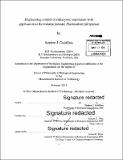Engineering control of eukaryotic translation with application to the malaria parasite Plasmodium falciparum
Author(s)
Goldfless, Stephen J. (Stephen Jacob)
DownloadFull printable version (12.98Mb)
Other Contributors
Massachusetts Institute of Technology. Department of Biological Engineering.
Advisor
Jacquin C. Niles.
Terms of use
Metadata
Show full item recordAbstract
Experimenter control of target gene expression is a fundamental component of molecular biology research. In many systems, tools exist that allow generalizable control of gene expression at the transcriptional or post-transcriptional level. Plasmodium falciparum, the protozoan parasite responsible for the majority of death and sickness due to malaria, remains challenging to manipulate in the laboratory. No robust and generalizable tool for gene expression control has been developed in the parasite. To address this need, we engineered a new system for control of protein translation in eukarvotes, and applied it to P. falciparum. This system is based on the ligand-regulated interaction between an RNA aptamers and the TetR-repressor protein. Although such protein-RNA interactions are abundant in nature and are known to effectively mediate control of gene expression, our system is unique in its direct modulation by an exogenous chemical. By genetically encoding TetR-binding RNA aptamers in the 5' untranslated region (5'UTR) of an mRNA, translation of a downstream coding sequence is repressed by TetR in vivo and induced upon adding a non-toxic tetracycline analog. We first define the system's component molecular interactions in vitro, followed by optimization of the constituent parts for convenience and performance. We then further optimize the system and validate its performance in two model systems, the budding yeast Saccharomvces cerevisiae and cell-free rabbit reticulocyte extracts. We show the broad utility of the system in P. falciparum for controlling expression of reporter and endogenous proteins trafficked to a variety of subcellular compartments. Induction and repression are rapid and homogeneous across the cell population. Placing a drug resistance determinant tinder inducible control, we are able to modulate P. falciparum drug sensitivity, demonstrating the usefulness of the system for controlling relevant parasite biology. In the process of constructing and validating a novel tool for gene expression in P. falciparum. we built a new series of gene expression vectors for molecular biology work in the parasite. In addition to developing optimized protocols for plasmid construction, we built a standardized, sequence-defined family of plasmids for malaria research. In all, we present a generalizable, well-defined toolkit for genetic programming of P. falciparum.
Description
Thesis: Ph. D., Massachusetts Institute of Technology, Department of Biological Engineering, 2014. Cataloged from PDF version of thesis. Includes bibliographical references (pages 123-130).
Date issued
2014Department
Massachusetts Institute of Technology. Department of Biological EngineeringPublisher
Massachusetts Institute of Technology
Keywords
Biological Engineering.